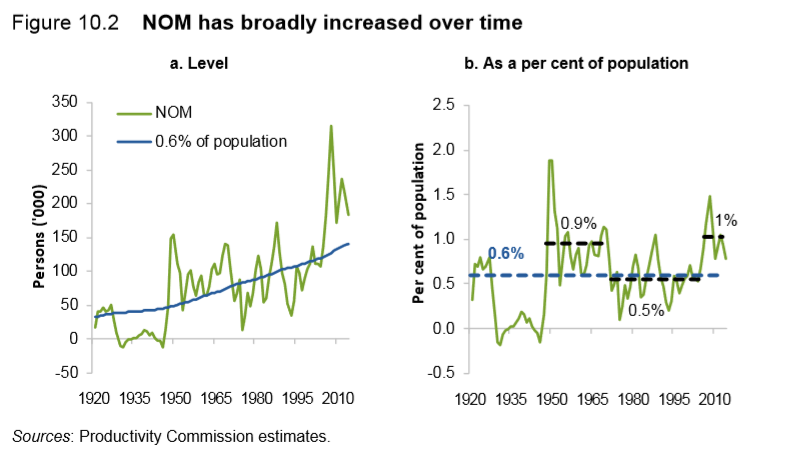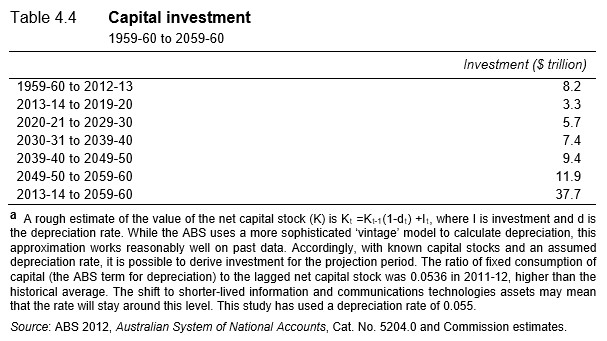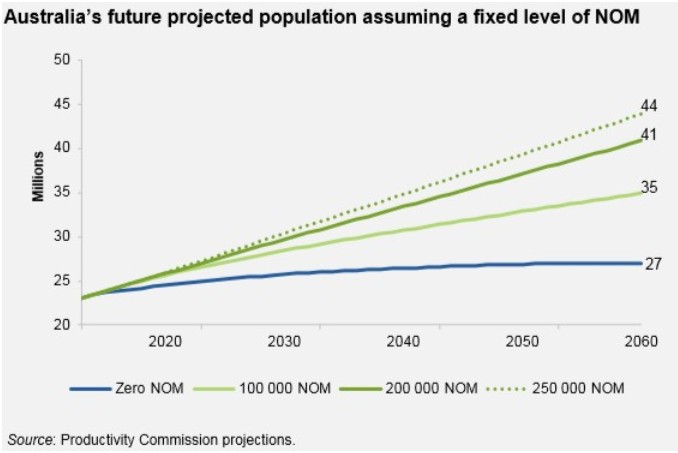Michael Pascoe has ended his tenure at Fairfax with one final immigration spruik. Let’s take a look at his key arguments:
The latest NOM figures are for the year to the end of September. They totalled 250,100 – representing close to one per cent of the Australian population. If the trend of subclass 189 visa invitations and temporary visa applications hold and international student visas are either steady or dip, NOM could be headed down to around 200,000…
At that level, NOM would be running at about 0.8 per cent of the population – not far off the average over the entire post-war period…
As I noted last time, Australia’s immigration intake as a percentage of population (currently 1%) is extreme by historical standards:

Even at a rate of 0.8% it would remain at extreme levels.
Second, and more importantly, it is not the immigration rate that matters for infrastructure, traffic congestion, or the environment, but rather the sheer numbers, which at 200,000 NOM per annum would be extreme (see above left chart).
Back to Pascoe:
[There are] two reasonable and common environmental concerns [i.e. water and power]. Both are infrastructure issues. Yes, we will have to invest in more infrastructure of all kinds as our population grows, just as we have had to invest in infrastructure for a couple of hundred years as Australia’s population has grown…
Environmentally, Australia has passed the time of burning more coal for more electricity. We’re going to be burning less coal and increased gas-fired generation is likely to be a passing phase as well…
For water, Australia actually has plenty – so much that we don’t bother to recycle it. We don’t even bother to use much grey water for our gardens… Yes, our major cities will have to get serious about water one of these days. Desalination is expensive – it’s what politicians reach for in a hurry when facing a crisis after failing to plan for the future. We shouldn’t blame population growth for political failures.
Beyond the obvious cities and despite the usual cliché about being the second-driest continent after Antarctica, we have plenty of water that we chose not to exploit. Drive the length of the east coast and you’ll rarely be far from a river.
Pascoe’s blasé’ statement about increasing infrastructure investment ignores some uncomfortable truths.
First, the required infrastructure task is massive. The Productivity Commission’s (PC) 2013 Ageing Australia report warned that total private and public investment requirements over the next 50 year period are estimated to be “more than 5 times the cumulative investment made over the last half century”, and this was off lower population projections that exist currently (i.e. 38 million by 2060 versus 40 million currently):

Meanwhile, the PC’s recent Shifting the Dial: 5 year productivity review explicitly noted that infrastructure costs will inevitably balloon due to our cities’ rapidly growing populations:
Growing populations will place pressure on already strained transport systems… Yet available choices for new investments are constrained by the increasingly limited availability of unutilised land. Costs of new transport structures have risen accordingly, with new developments (for example WestConnex) requiring land reclamation, costly compensation arrangements, or otherwise more expensive alternatives (such as tunnels).
Blind Freddy can see that there is little hope of achieving the level of investment required to sustain current levels of mass population growth: we have witnessed the results first hand over the past decade. And even if we did, user costs would soar, lowering living standards.
Moreover, the notion that Australia should “exploit” all of the scarce water from our rivers to support immigration is ludicrous and environmentally destructive.
Back to Pascoe:
Who benefits from a bigger population? Over my lifetime, we all have… We have more choices, more vibrancy and, per capita both on average and individually, more wealth. Yes, we have a couple of cities that are feeling growth pains at present, but neither is gargantuan and, time and again, it’s the vibrancy of big cities that provides productivity and creativity growth.
Ah yes, the old vague ‘vibrancy’ argument – the argument you make when don’t have a coherent argument. Oh well, at least Pascoe didn’t play the ‘racism’ and ‘xenophobia’ card.
Moreover, who exactly is calling for Australia’s population to stop growing (or to shrink), rather than merely growing at a slower, more sustainable rate? Heck, lowering immigration to the historical average of 70,000 people a year – as advocated by MB, Dick Smith, Sustainable Australia, and others – would still see Australia’s population hit around 32 million people by 2060:

Is this not big enough?
In any event, let’s do the democratic thing and put it to a plebiscite at the next federal election so that the Australian people can decide how ‘big’ Australia is to become.

